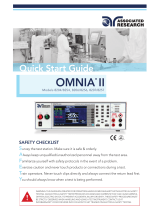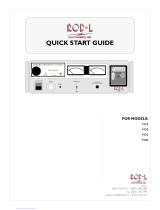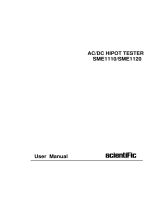Page is loading ...

Hypot
®
III
Models 3705, 3765, 3770 and 3780
SAFETY CHECKLIST
Survey the test station. Make sure it is safe & orderly.
Always keep unqualied/unauthorized personnel away from the test area.
Familiarize yourself with safety protocols in the event of a problem.
Exercise caution and never touch products or connections during a test.
Train operators. Never touch clips directly and always connect the return lead rst.
You should always know when a test is being performed.
WARNING: THIS GUIDE WAS CREATED FOR OPERATORS HAVING SOME FAMILIARITY WITH ELECTRICAL SAFETY
TESTING. AN ELECTRICAL SAFETY TESTER PRODUCES VOLTAGES AND CURRENTS THAT CAN CAUSE HARMFUL
OR FATAL ELECTRIC SHOCK. TO PREVENT ACCIDENTAL INJURY OR DEATH, THESE SAFETY PROCEDURES MUST
BE STRICTLY OBSERVED WHEN HANDLING AND USING A TEST INSTRUMENT. CONTACT US AT
INFO@ARISAFETY.COM FOR MORE INFO ON HOW TO GET TRAINED ON ELECTRICAL SAFETY TESTING.
Quick Start Guide
HypotIII-QSG-MARCH17.indd 1 4/13/17 11:09 AM

Select the correct input line voltage on the rear panel of the instrument,
either 115 VAC or 230 VAC.
Connect the female end of the standard NEMA style line power cord into the
input power receptacle on the rear panel of the instrument. Plug the male
end of the cord into a grounded power source.
Connect the Interlock Disable Key into the signal input connector on the rear
panel of the instrument. This is required to run a test.
Turn the instrument power switch ON.
The initialization screen will appear. After three seconds the Perform Test screen
will appear as shown below.
3705, 3765, 3770
3705, 3765, 3770
3705, 3765, 3770
Perform Test Screen
WARNING: LOCATE A SUITABLE TESTING AREA WITH A THREE-PRONG, GROUNDED
OUTLET. BE SURE THAT YOUR THREE-PRONG OUTLET HAS BEEN TESTED FOR PROPER
WIRING. READ THE SAFETY CHECKLIST OF THIS GUIDE BEFORE STARTING TO TEST.
INSTRUMENT SETUP
2
3780: Automatic Selection
3780
3780
To Grounded
Power Source
HypotIII-QSG-MARCH17.indd 2 4/13/17 11:09 AM

EDIT SYSTEM PARAMETERS
PERFORM A GROUND CONTINUITY CHECK
Congure the instrument system parameters to your preferences. The instrument
system parameters are global and will affect all tests that you perform regardless
of memory location and memory step.
You can easily perform a Ground Continuity check on Class I products through the
use of the adapter box (P/N 36544) provided with the instrument and ground return
lead. To enable this function, you will need to set the instrument to run either an AC
or DC Hipot test.
Note: If you need to preform a Ground Continuity check on your DUT, be sure to enable
the Ground Continuity test before moving forward.
3
From the Perform Test screen,
select the MENU soft key.
DCW Settin
g
s
M1-1 0.0s
______________
Menu
kV
uA
Select EXIT twice to save changes
and return to the Perform Test screen.
PLC Remote OFF
Single Step ON
Alarm 5
Contrast 1
Results Last
Lock OFF
Mem Lock ON
<More>
+
Exit
>
>
Select the SYSTEM soft key.
M1-1 DCW
Settin
g
s
____________
O.3OkV
5OOOuA
O.OuA
O.Os
Results
Test
System
Exit
Select the MENU soft key.
PLC Remote OFF
Single Step ON
Alarm 5
Contrast 1
Results Last
Lock OFF
Mem Lock ON
<More>
+
Exit
>
>
Select a parameter to edit by
scrolling with the and soft keys.
Select the + soft key to change
the parameter.
M0-1 ACW
Settin
g
s
____________
O.0OkV
10.OOuA
O.O00mA
1.Os
Menu
Memory
Step
Exit
M0-1 ACW
Settin
g
s
____________
O.0OkV
10.OOuA
O.O00mA
1.Os
Menu
Memory
Step
Exit
START
From the Perform Test screen,
select the MENU soft key.
Select the TEST soft key.
Select Edit soft key. Use the + and -
soft keys to select ON.
Select ENTER to save changes.
Select EXIT twice to return to the
Perform Test Screen.
Arc Sense O
Continuit
y
ON
Max Lmt 1.5OΩ
Min Lmt O.OOΩ
Offset O.50Ω
Connect OFF
+
-
Edit
Esc
Arc Sense O
Continuit
y
ON
Max Lmt 1.5OΩ
Min Lmt O.OOΩ
Offset O.50Ω
Connect OFF
+
-
Enter
Exit
DCW Settin
g
s
M1-1 0.0s
____________________________
Menu
kV
uA
M1-1 DCW
Settin
g
s
________________
O.3OkV
5OOOuA
O.OuA
O.Os
Results
Test
S
y
stem
Exit
Use the arrow key to select
CONTINUITY on the next screen.
Test T
y
pe DCW
Volta
g
e O.3OkV
Max Lmt 5OOOuA
Min Lmt O.OuA
Ram
p
UP O.1s
Dwell O.Os
Ram
p
DN O.Os
<More>
Edit
Exit
>
>
Select the MENU soft key.
M0-1 ACW
Settin
g
s
____________
O.0OkV
10.OOuA
O.O00mA
1.Os
Menu
Memory
Step
Exit
M0-1 ACW
Settin
g
s
____________
O.0OkV
10.OOuA
O.O00mA
1.Os
Menu
Memory
Step
Exit
HypotIII-QSG-MARCH17.indd 3 4/13/17 11:09 AM

EDIT TEST PARAMETERS
START
From the Perform Test screen,
select the MENU soft key.
Select the TEST soft key.
Select ENTER to save changes.
DCW Settin
g
s
M1-1 0.0s
______________
Menu
kV
uA
M1-1 DCW
Settin
g
s
____________
O.3OkV
5OOOuA
O.OuA
O.Os
Results
Test
System
Exit
Test T
y
pe ACW
Volta
g
e 1.24kV
Max Lmt 1O.OOmA
Min Lmt O.OOOmA
Ram
p
UP O.1s
Dwell 1.Os
Ram
p
DN O.Os
<More>
Edit
Exit
>
>
Test T
y
pe ACW
Volta
g
e 1.24kV
Max Lmt 1O.OOmA
Min Lmt O.OOOmA
Ram
p
UP O.1s
Dwell 1.Os
Ram
p
DN O.Os
<More>
Enter
Esc
>
>
Test Type will be highlighted. Select
EDIT and then use the "+" soft key
to toggle between AC, DC, or IR.
Test T
y
pe ACW
Volta
g
e 1.24kV
Max Lmt 1O.OOmA
Min Lmt O.OOOmA
Ram
p
UP O.1s
Dwell 1.Os
Ram
p
DN O.Os
<More>
Edit
Exit
>
>
Use the and arrow keys to
select another parameter to edit.
Test T
y
pe ACW
Volta
g
e 1.24kV
Max Lmt 1O.OOmA
Min Lmt O.OOOmA
Ram
p
UP O.1s
Dwell 1.Os
Ram
p
DN O.Os
<More>
Edit
Exit
>
>
Select EDIT and then use the "+"
and "-" soft keys to edit additional
parameters.
Select ENTER to save changes for
each parameter.
Test T
y
pe ACW
Volta
g
e 1.24kV
Max Lmt 1O.OOmA
Min Lmt O.OOOmA
Ram
p
UP O.1s
Dwell 1.Os
Ram
p
DN O.Os
<More>
Enter
Esc
>
>
Test T
y
pe ACW
Volta
g
e 1.24kV
Max Lmt 1O.OOmA
Min Lmt O.OOOmA
Ram
p
UP O.1s
Dwell 1.Os
Ram
p
DN O.Os
<More>
Edit
Exit
>
>
Once each test parameter has been
edited, select EXIT twice to return to
the Perform Test Screen.
Select the MENU soft key again.
M0-1 ACW
Settin
g
s
____________
O.0OkV
10.OOuA
O.O00mA
1.Os
Menu
Memory
Step
Exit
You may congure your test routine by following the outlined steps:
With our PPE Safe
Workstation Packages
KEEP YOUR
OPERATOR SAFE
Scan for details
HypotIII-QSG-MARCH17.indd 4 4/13/17 11:09 AM

TEST CONNECTION
Adapter Box Connections
To increase operator safety, you may elect to use an adapter box for products
terminating in either a two-prong or three-prong line cord.
Plug the black lead from the adapter box (P/N 36544) into the CONT.
CHECK terminal located on the front panel.
Plug the white lead (P/N 4040A-08) from the adapter box into the high
voltage output terminal located on the front panel.
Connect the black ground return lead (P/N 2100A-13) to the front panel
return terminal and connect the other end of the lead to the dead metal
on the chassis of the DUT. Check to ensure a solid connection is made
between the DUT and the return clip.
Plug the line cord of the DUT into the adapter box receptacle.
5
WARNING: DO NOT TOUCH THE DEVICE UNDER TEST ONCE YOU START THE TEST.
Note: Be sure to enable the Ground Continuity check before moving forward (see page 3).
CAUTION
HIGH VOLTAGE
5KVAC MAX.
6KVDC MAX.
NL
POWER
CAUTION
5KVAC MAX.
6KVDC MAX.
H.V.
RETURNTESTRESET CONT.
CHECK
DIELECTRIC WITHSTAND TESTER
HypotIII-QSG-MARCH17.indd 5 4/13/17 11:09 AM

POWER
CAUTION
5KVAC MAX.
6KVDC MAX.
H.V.
RETURNTESTRESET CONT.
CHECK
DIELECTRIC WITHSTAND TESTER
Connect the clip end of the return lead (P/N 2100A-13) to the exposed or
dead metal of the chassis of the DUT. Always connect the ground return clip
rst and double check that it has a solid connection to the DUT.
Connect the black ground return lead (P/N 2100A-13) to the Return terminal
located on the front panel of the instrument.
Connect the red high voltage lead (P/N 4040A-08) to the H.V. terminal.
Connect the clip end of the high voltage lead to the current carrying
conductors of the DUT’s circuity.
6
TEST CONNECTION
DUT Connections
Exposed Metal Chassis Setup
WARNING: DO NOT TOUCH THE DEVICE UNDER TEST ONCE YOU START THE TEST.
If your chassis does not have any exposed metal, you can wrap the enclosure
of the DUT in foil and then connect the return lead to the foil.
Non-Exposed Metal Chassis Setup
POWER
CAUTION
5KVAC MAX.
6KVDC MAX.
H.V.
RETURNTESTRESET CONT.
CHECK
DIELECTRIC WITHSTAND TESTER
FOIL
HypotIII-QSG-MARCH17.indd 6 4/13/17 11:09 AM

7
WARNING: DO NOT TOUCH THE DEVICE UNDER TEST ONCE YOU START THE TEST.
CONDUCT A TEST
TEST RESULTS
Connect the Interlock Disable Key (P/N 38075) to the signal input
connector on the rear panel of the instrument. If you’re not utilizing a
DUT enclosure (P/N 39064 or 39656) or other safety device, the Interlock
Disable Key is required in order to run a test.
With the instrument set to the desired test type and your DUT correctly
connected to the instrument, you are now ready to start testing.
If the Continuity function is ON and the resistance of the ground circuit
is less than the Max Resistance setting, the green TEST button will
illuminate.
Push the green TEST button on the front panel. The DUT is tested for
a duration equal to the Ramp and Dwell settings.
PASS: If the DUT passes the test, you will hear a short audible beep and the
display will indicate the test results.
FAIL: If a failure occurs, you will hear a long audible alarm and the red ashing
indicator will light up. Press the red RESET button to stop alarm.
Pass/Fail Indication Screen
HypotIII-QSG-MARCH17.indd 7 4/13/17 11:09 AM

For additional information about these and other key features of the Hypot
®
III, please consult the
full Operation and Service Manual or call us toll-free 1-800-858-TEST (8378) or +1-847-367-4077
© 2017 Associated Research • arisafety.com
3/2017
Safety Is Our Only Focus
®
SCAN FOR
QUICK
START
VIDEO
FOLLOW US!
HypotIII-QSG-MARCH17.indd 8 4/13/17 11:09 AM
/





